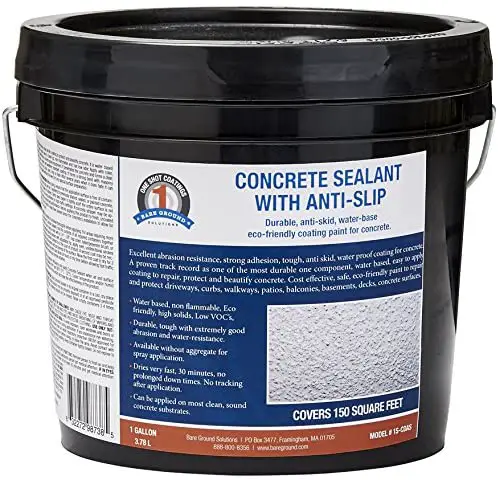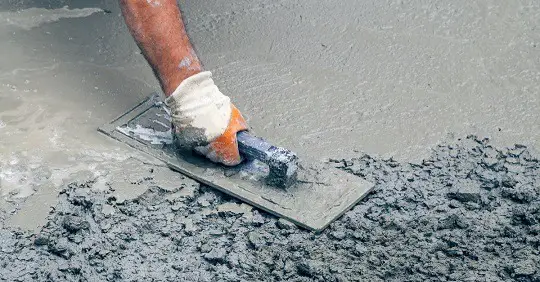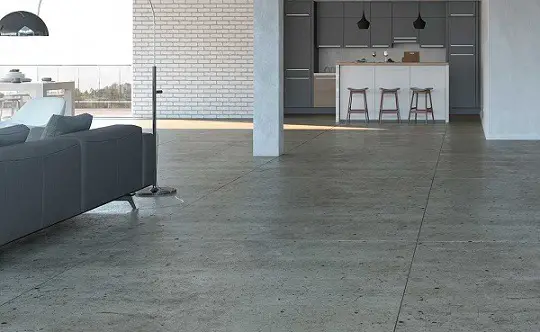Concrete has a decorative feature that adds to the visual appeal of the surface. However, if care isn’t taken it can be a source of many accidental slips thus a safety risk.
Cases of slips on the concrete surface have been on the rise lately. This affects not only the elderly and children but also youths in their prime age. You can break your bones, hurt your head, or even lose your life through a simple slip.
If you have any concrete surface in your home, it is important that you ensure it’s protected from fluids and other agents that can make it slippery.
There are many ways you can make your concrete floor non-slippery.
It is better to take the necessary precautions as it is better safe than sorry. The following are ideal ways of safeguarding your concrete floor.
Ways to make concrete floors non-slippery
Anti-Slip Sealer

Anti-slip Sealers gets to the pores of the surface beneath, increasing its strength from underneath. They do this without altering the texture or appearance of the surface.
Walking on the sealer coating guarantees comfort without the risk of slipping. Furthermore, you can also use a water repellent sealer that minimizes surface water retention.
Non-Slip Additives
For those who find the anti-slip sealer ineffective, you can add non-slip additives. They are probably in the same store you bought the anti-slip sealer.
They are available in all textures, depending on the amount of traction needed to make the floor less slippery.
Some believe the addition of aluminum oxide grits to the sealer is a perfect non-slip additive.
The material is cost-friendly, and comes in a substantial amount hence covers a big area. It is also available in multiple colors so you can blend it with the color of your tiles.
Silica Sand
Silica sand can also be another alternative. Place the silica on the wet concrete sealer. On top of the silica sand, add more concrete to give you a non-slippery finishing.
Silica may change the appearance of your concrete to milky or cloudy. However, it is better than risking your safety.
Non-Slip Strips
It is not the most aesthetic way to make your concrete less slippery, but it is easy and effective. It is only applicable to outdoor concrete surfaces. The strips are available in various widths, colors, and designs.
You can stick them on the surface in a stylish way, to make it look like your own design rather than a means to avoid slippery floors.
Hydrochloric or Muriatic Acid

Muriatic acid, also referred to as hydrochloric acid is another effective way to reduce concrete slipperiness. The acid eliminates the top layer of the concrete, exposing the sand in the concrete.
This will make the surface of the concrete a bit rough like that of sandpaper. This makes your floor safer even when wet. When applying this method, wear protective gear to avoid acid burns.
Prime and Paint
These methods involve the addition of grit as you prime and paint the concrete surface. Clear grit and silica work in a similar way; only that clear grit does not give your concrete a cloudy appearance.
You can use sawdust and sand to make grit though there is the commercial grit, which easily combines with the paint and make it less slippery.
Color Hardener
The use of color hardener is another preferred method used by the contractors. By using a simple hardener, you’ll notice a great difference.
It doesn’t change the visual appearance of the concrete. It is the most durable method so far in comparison to the rest.
Rock Salt
You can as well add some rock salt to provide grip on your surface. Add the salt before the cement dries up, and then make it smooth using a trowel.
Adding rock salt to dried concrete will have it easily washed away. Furthermore, it adds texture to the concrete bringing about a beautiful finish.
Good quality concrete

The key thing is always to have the best quality concrete to avoid over-reliance on the sealer. Having a good quality concrete with a good paint job will require a thin layer of sealer to prevent any slips on the concrete surface.
Moreover, using little amounts of sealer prevents plastic build accumulation. The more the sealer or grit you add, the higher the chances of having the seal fail in the future, which beats its purpose.
In the application of concrete, it is better to use a wooden float or broom instead of a trowel. A trowel makes the concrete sticky.
This leaves a sandier texture, which still does make the floor less slippery, while a wooden float or a broom gives it a good finishing making the floor less slippery and easy to sweep.
These methods have been tried, tested, and proven to be effective. Discuss with the manufacturer to establish your best option. It is better to take caution before it is too late.


